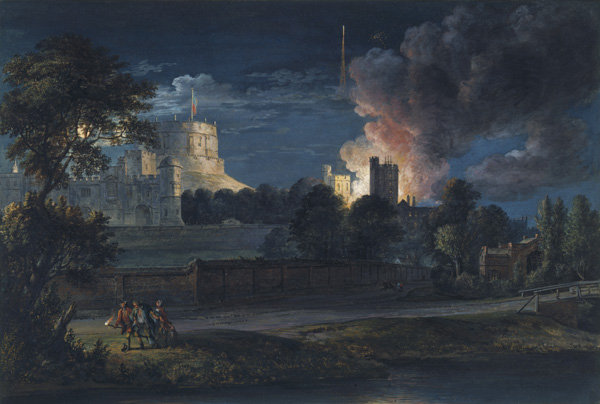Paul Sandby
dal 6/11/2009 al 6/2/2010
Segnalato da
National Galleries of Scotland's Press Office
6/11/2009
Paul Sandby
National Gallery Complex - The Mound, Edinburgh
Picturing Britain - A Bicentenary Exhibition. The exhibition features over one hundred loans, including oil paintings, watercolours, gouaches, prints and sketchbooks, coming from all the major collections which house his work: The Royal Collection, The British Museum, The British Library, The Victoria and Albert Museum and The Yale Center for British Art. It also showcases outstanding works from private collections.

Paul Sandby: Picturing Britain looks at all aspects of Sandby's career and includes studies of rural and urban views, street scenes, royal parks and ancient castles. Sandby explored a broader range of subject matter than any previous artist in Britain and was integral in refining the use of watercolour. This exhibition features over one hundred loans, including oil paintings, watercolours, gouaches, prints and sketchbooks, coming from all the major collections which house his work: The Royal Collection, The British Museum, The British Library, The Victoria and Albert Museum and The Yale Center for British Art. It also showcases outstanding works from private collections. Paul Sandby: Picturing Britain was organised by Nottingham City Museums and Galleries in association with the National Galleries of Scotland, Edinburgh and the Royal Academy of Arts in London.
Sandby's early career
At the beginning of his career, Sandby worked as Chief Draughtsman on the Military Survey of North Britain, and began to make an impact on the London art world. Sandby's employment as a cartographer meant that he travelled around Edinburgh and up to the Highlands. While not working on the Survey, he became fascinated by the towns, forts, houses, people and dramatic scenery that he encountered, making sketches which were used as the basis for prints and watercolours over the coming years. These works encompassed a wide range of pictorial conventions, including naturalistic landscapes and idealised Italianate views.
Arriving in London in 1751, Sandby immersed himself in the city's vibrant artistic community. Clearly intending to draw attention to his skills and ambition, in 1753-5 he created a remarkable series of printed satires aimed at undermining William Hogarth, the key British artist of the previous generation. Paul's elder brother Thomas Sandby had important connections at Court, and this opened up for him access to a powerful network of patronage.
Roads and Street Life
Sandby travelled extensively across Britain and made the traffic he encountered on country roads and city streets as much the subject of his art as the surrounding landscapes or urban vistas. During his life the number of travellers crossing the country, prompted by trade, business, pleasure or military movements increased, and numerous new roads were built. In Edinburgh Sandby appears to have delighted in recording the rich variety of contemporary life; his sketches of street scenes include shoppers, traders, beggars, soldiers and pleasure-seekers. This plentiful stock of imagery was re-used by the artist throughout his career. In 1760 in London Sandby created prints of Twelve Cries 'done from life' which illustrate the range of produce that could be bought on the streets and the characters who purveyed it.
Antiquities
Historic architectural subjects formed a key subject for Sandby. His patrons with antiquarian tastes were fascinated by the castles, ruins and venerable city centres that could be recorded across the country. Sandby's mastery of perspective and texture gave a remarkable accuracy to these studies, as did his sensitivity to the issue of how buildings are located within a landscape. Sandby's most distinguished depictions of such subjects were the outstanding series of works he produced at Windsor, where his brother Thomas was Deputy Ranger of the Great Park. Paul Sandby painted every aspect of the castle, creating a remarkable record of its complex evolution, and even producing nocturnal views of electric storms and fireworks. Sandby continued to draw on his interest in Scottish antiquities later in his life, notably creating in about 1780 an impressive view of Roslin Castle, south-west of Edinburgh.
Estates
Commissioned views of country estates, celebrating the wealth and taste of their owners, were common in the eighteenth century. Sandby excelled at creating them, in oil, gouache and watercolour. He was interested in depicting a remarkable range of subjects that can be associated with this category of painting, which included royal and aristocratic parks, domestic gardens and agricultural, industrial and imaginative views. Among his outstanding works of this type is Sandby's stunning View of Vintners at Boxley, Kent. Dating from 1794, it was painted for the celebrated papermaker James Whatman II and shows his house and paper mill in an idyllic landscape near Maidstone. Contrasting with such serene scenes are the artist's late, dramatic woodland landscapes, such as The Rainbow, a celebration of rural life which draws inspiration from the pictures of Rubens.
Image: Paul Sandby, Windsor Castle from Datchet Lane on a Rejoicing Night
The Royal Collection © 2009 Her Majesty Queen Elizabeth II
Opening 7th November 2009
National Gallery Complex
The Mound +44, Edinburgh
Opening Hours: Open daily, 10am-5pm
Late night opening every Thursday until 7pm
free admission



